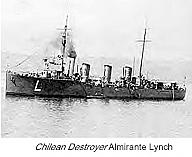 In the early 1900s, South America was caught up in a naval arms race. The
principal parties were Chile, Brazil and Argentina. This scenario imagines a
conflict between two of these powers: Chile and Argentina.
In the early 1900s, South America was caught up in a naval arms race. The
principal parties were Chile, Brazil and Argentina. This scenario imagines a
conflict between two of these powers: Chile and Argentina.
Chilean Destroyer Almirante Lynch
On November 22, 1910 the crew of the Brazilian dreadnought Minas Gerais mutinied. Brazil’s economy had collapsed and her interests turned inward, leaving Argentina and Chile alone to deal with each other. Britain had interests in Chile (copper mines, nitrates) and had fixed the bidding process for dreadnoughts in Chile.
America had built the Argentine dreadnoughts. The American business establishment was upset and this cooled off relations between the two countries. Germany’s threat to both countries’ interests kept things from escalating there.
For the purposes of this scenario, assume the Germans are busy in Europe and cannot prevent Chile and Argentina from coming to blows. Also assume America prevented England from coming to Chile’s aid. Also, assume that the ships built in Britain for Chile were completed before the start of hostilities and were thus not taken over by Britain.
Location:
Off the coast of Valparaiso, Chile. February 17, 1916
Operational Situation:
Argentina and Chile had border disputes along the Andes mountains. Several border clashes had broken out, with Argentina unsatisfied with the result (this dispute was actually resolved by a treaty signed in 1916). The Argentine government decided to punish the Chileans.
Tactical Situation:
An Argentine force is approaching Valparaiso with the intent of shelling the port and naval facilities. The Chileans, as a precaution against such an attack, have stationed their forces off the port.
Environment:
This part of the world is infamous for its storms and heavy seas. Since the Argentines have no way to predict what the weather will be until they arrive, roll randomly for the weather when the scenario is about to begin.
If the conditions are unsuitable (visibility 25% or less, Sea State 6 or more), the Argentines can remain off the coast, attempting to avoid the Chilean forces (which may or may not want to give battle), until the weather improves. The players can roll every six hours to see if the conditions change. If the game is being refereed, he can roll for the weather for several days of game time before play starts.
Chilean Forces:
- Almirante Latorre (BB)
Almirante Lynch, Almirante Condell, Almirante Williams, Almirante Uribe, Almirante Riveros (all Al. Lynch class DDs)
Chilean Orders:
Defend the port, but do not lose Almirante Latorre.
Chilean Victory Conditions:
- Decisive: The port is not shelled and Almirante Latorre receives less than 50% damage.
Tactical: Valparaiso receives a total of less than five turns of fire from the Argentine dreadnoughts, and Almirante Latorre receives no more than 50% damage.
Argentine Forces:
- Rivadavia, Moreno (both Rivadavia class BBs)
Catamarca, Jujuy (both Catamarca class DDs)
La Plata, Cordoba (both La Plata class DDs)
San Luis, Tucuman (both San Luis class DD)
Argentine Orders:
Shell the port of Valparaiso for a total of twenty turns. Do not lose either dreadnought to Chilean fire.
Argentine Victory Conditions:
- Decisive: Valparaiso is shelled for a total of twenty turns and neither Argentine dreadnought is damaged more than 25%.
Tactical: Valparaiso is shelled for a total of ten turns and neither Argentine dreadnought is damaged more than 50%.
Setup
Place a 5 nm circle on the playing surface. The argentine forces must bombard Valparaiso from this circle to be in range. The Argentine force is approaching from the south. Place it 5 nm beyond maximum visual detection range to the south of the circle.
The Chilean forces bear D6*60°, D6 nm from the circle.
Variation:
Delay the battle a year and add a sister to the Almirante Latorre, Almirante Cochrane.
Note:
This also pits American-built dreadnoughts against British-built ones. Victory conditions would also have to take in mind that each of these forces represent the investment of a nation’s entire GNP. A sunk battlewagon could bankrupt a country’s armed forces.
Historical Note:
The two Argentine dreadnoughts were the only dreadnoughts not to participate in WW I.
Almirante Latorre was seized at the beginning of the war by Britain and served as HMS Canada. Almirante Cochrane was under construction and was converted into HMS Eagle. While the two Argentine dreadnoughts were built in America, the optical system was installed in Germany.
Rivadavia left Germany only two months before the outbreak of hostilities.
What if Germany seized these battleships the way Britain seized Agincourt, Canada and Erin? Add these two battleships to the German OB at Jutland. They were very good ships.
Annex A: Listings for The Battle of Valparaiso
BT
Back to The Naval Sitrep #22 Table of Contents
Back to Naval Sitrep List of Issues
Back to MagWeb Master Magazine List
© Copyright 2002 by Larry Bond and Clash of Arms.
This article appears in MagWeb (Magazine Web) on the Internet World Wide Web.
Other military history and related articles are available at http://www.magweb.com